Table of contents
HubSpot is powerful, but let’s be honest—it’s not a solo act.
Whether it’s streamlining marketing campaigns, automating sales processes, or centralizing customer data, the right integrations can make or break your processes and operations.
Yet, with hundreds of integrations available, many businesses struggle to find the ones that truly deliver value.
We didn’t want guesses or theories – that’s why we teamed up with multiple partners and surveyed 50+ companies to learn which HubSpot integrations are most commonly used, how businesses leverage these tools, and what tangible benefits they deliver.
Here’s what we found:
- Our Key Findings on How Companies Use HubSpot in 2024
- Best HubSpot Integrations and Their Impact on Business Growth
- How HubSpot Integrations Address Key Challenges and Goals
- Maximize the Power of Your HubSpot Integrations with Databox
Our Key Findings on How Companies Use HubSpot in 2024
Our research reveals how companies, particularly small and mid-sized businesses, are using HubSpot to streamline operations and achieve their goals.
Smaller teams have been the most active in our survey, with most of our respondents having 50 employees or less.
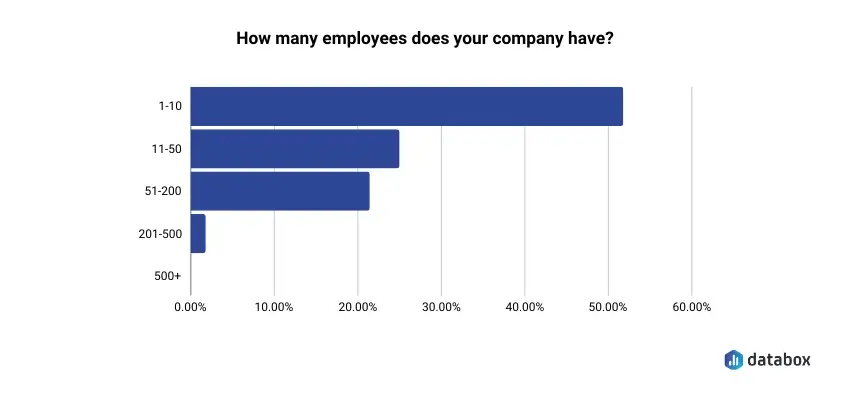
When it comes to experience with the tool, most of the surveyed companies have been using HubSpot between 1 and 5 years. There’s a strong adoption rate in recent years as companies prioritize comprehensive CRM systems.
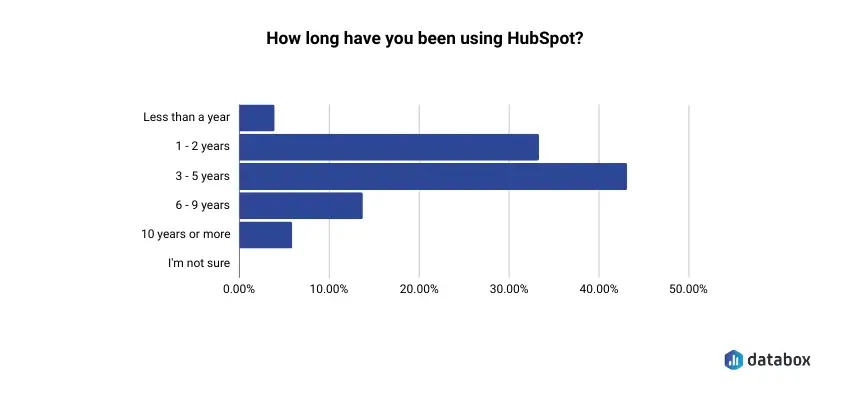
In terms of functionality, Marketing Hub is the most frequently used hub, while Operations Hub is the least used hub (almost 30% of the respondents don’t use it). From what we found, there’s a clear preference for marketing-focused features over backend operational tools.
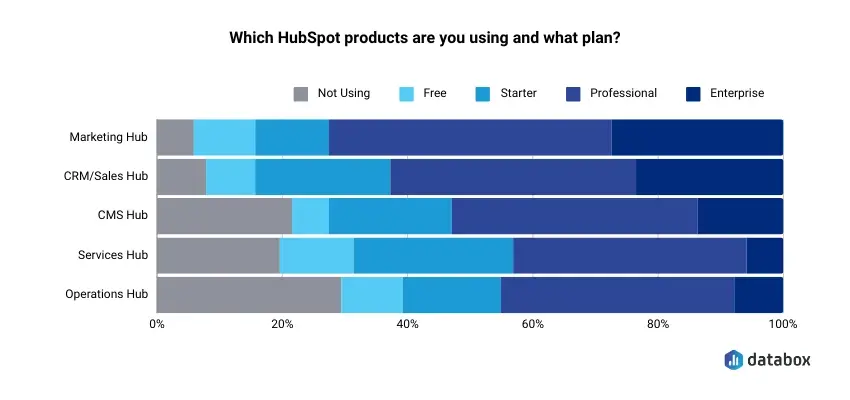
Integration choices also reveal interesting trends. Most survey respondents have Gmail and Google Calendar integrated with HubSpot. Shy of 50% also had Google Ads integrated.
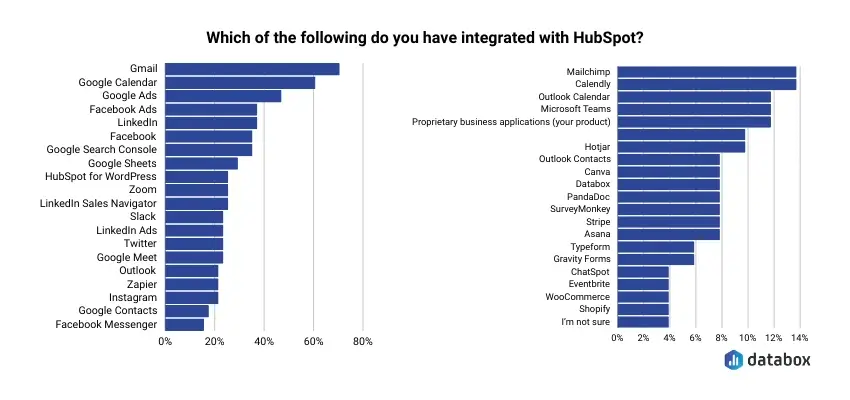
Finally, when it comes to tools connected to HubSpot, most respondents voted for CRM tools, email services, ecommerce platforms, and Zapier as their top choices.
Best HubSpot Integrations and Their Impact on Business Growth
HubSpot is only as powerful as the tools you connect it with. The right integrations don’t just make your workflows smoother—they can directly affect your sales, marketing, and customer service results.
Here are the best HubSpot integrations that our respondents mentioned, with details on how they helped them improve business operations:
- Google Ads
- LinkedIn Sales Navigator
- Salesforce
- Shopify
- Facebook Ads
- Google Search Console and Google Analytics
- Zendesk
- Stripe
- Mailchimp
Google Ads
Integrating Google Ads with HubSpot creates a powerhouse for managing and optimizing your paid advertising campaigns.
You can use it to track ad performance and ROI directly in HubSpot, so you can see which campaigns and keywords are driving the most leads and revenue.
Instead of juggling between platforms, you can synchronize your Google Ads data with HubSpot’s CRM to see the entire customer journey—from the first click on an ad to the final conversion.
You can also build smarter audiences. Using HubSpot’s contact data, you can create precise retargeting campaigns or lookalike audiences in Google Ads, so your marketing dollars are spent on the right prospects.
Manoj Kumar of Orderific said that their team finds the “Google Ads integration with HubSpot outstanding!”
“It lets us manage and track all ads directly from HubSpot – saving us time with comprehensive updates. This integration refines our budget management and audience targeting – boosting our overall campaign performance. The Analytics also shows how our ads are performing and it also highlights areas to improve – ensuring a great return on investment. Overall, it simplifies our data, makes our advertising better, and boosts our marketing efforts.”
LinkedIn Sales Navigator
With LinkedIn Sales Navigator integration, you can bridge the gap between social selling and CRM, so your sales team can build stronger relationships with prospects.
This integration provides sales reps with access to LinkedIn insights directly within HubSpot, such as shared connections, recent activities, and mutual interests, which makes outreach more personalized and effective.
You can also sync leads and accounts from LinkedIn Sales Navigator into HubSpot, so your CRM is always up to date with the latest connections and opportunities. This eliminates manual data entry and reduces the risk of missing follow-ups.
Jarrod Wright of Chargebacks911 says that he “thinks the Sales Navigator integration brings the most value to our daily tasks. It gives us fast and accurate insight into many of the contacts that inbound and drastically reduces the amount of time our SDRs need to spend researching prospects.”
Reed Daniels of Rail Trip Strategies also said how the “LinkedIn Sales Navigator and HubSpot integration is a significant improvement. As part of our outbound sales cadence, we utilize three main channels. Phone, Email, and LinkedIn InMail. This integration combines two extremely powerful sales tools (HubSpot and Sales Navigator) to save us time and nearly automate an outreach step.”
Salesforce
Salesforce and HubSpot integration ensures that data flows smoothly between Salesforce’s advanced CRM features and HubSpot’s marketing automation capabilities, so you can build a unified view of the customer journey.
It also simplifies lead management by syncing contacts, deals, and opportunities between the two systems.
Marketing teams can track how their campaigns influence Salesforce deals, while sales teams gain visibility into the nurturing activities that drive leads down the funnel. Real-time data synchronization ensures that both teams work with the most up-to-date information.
What’s more, marketers can attribute revenue to specific campaigns within HubSpot, while sales teams can analyze customer interactions in Salesforce to refine their strategies.
Sergey Taver of Precision Watches shared their perspective:
“As a Marketing Manager at Precision Watches, I often rely on integrating HubSpot with Salesforce. This combination provides a robust solution for aligning sales and marketing efforts. The seamless integration enhances lead tracking and customer data management, which is crucial for targeted marketing campaigns. It empowers us to create more personalized customer experiences and improves our conversion rates.”
PRO TIP: Want an easier way to track your Salesforce pipeline metrics? You can use our free Salesforce Sales Pipeline Dashboard to connect your most relevant metrics and KPIs in one place and see your progress in real-time – from expected revenue to opportunities won.
Shopify
Connecting Shopify with HubSpot equips eCommerce businesses with the tools to create seamless customer experiences while optimizing marketing strategies.
Online stores can automatically sync Shopify data, including customer information, orders, and products, directly into HubSpot, providing a centralized platform for managing customer relationships.
With this integration, you can leverage HubSpot’s marketing automation to create targeted email campaigns based on Shopify purchase behavior. For instance, you can send personalized post-purchase emails, abandoned cart reminders, or exclusive offers to loyal customers.
The integration also helps with better segmentation, so you can tailor your messaging to different customer groups based on their shopping habits or lifecycle stages.
Sturgeon Christie of Second Skin Audio talked about how “one of our most preferred HubSpot integrations is the Shopify integration.”
“This tool bridges our online store with HubSpot’s powerful CRM capabilities, streamlining both sales and customer relationship management. It automates critical processes such as order tracking and customer data synchronization, making it invaluable for managing our ecommerce operations effectively.”
Facebook Ads
With this integration, you can track the performance of Facebook ad campaigns directly in HubSpot, measuring metrics like impressions, clicks, conversions, and ROI in one place.
One big feature is audience synchronization – you can create custom audiences in Facebook Ads based on HubSpot contact lists, so your ads target the right people with precision.
For example, you can target leads at specific lifecycle stages or retarget existing customers with upsell opportunities. The best thing is that HubSpot automatically updates these audiences as new contacts are added or updated.
Brandon Fowler of Machinist Guides says that a “big part of my (and arguably anybody’s) business is reaching the correct audience – whether for sales or just engagement, and that’s why I find the Facebook integration tool so important.”
“HubSpot’s integration with Facebook Lead Ads allows me to capture leads directly from Facebook, automatically syncing them with HubSpot’s CRM, making it easier to manage and nurture them without manual data entry.
As well as this, because of the amount of user data available through the Facebook integration, it makes it easier for me to create more highly targeted ad campaigns that will reach my ideal audience. This ease of use is essential for any smaller team, and engaging with something like this can take off a lot of pressure and free up a lot of time.”
PRO TIP: Are you having trouble staying on top of your Facebook Ads engagement metrics? With our free Facebook Ads Campaign Performance Dashboard, it’s never been easier to keep track of your metrics. You can see campaign performance daily, track the best-performing ads, and monitor all key indicators in a single dashboard.
Google Search Console and Google Analytics
When it comes to understanding your website’s performance, integrating Google Search Console and Google Analytics with HubSpot is a no-brainer.
Google Search Console reveals how your content performs in search results, while Google Analytics analyzes the user behavior on your site. Then, HubSpot brings it all together in one place.
For example, say you’re running a content campaign targeting a high-value keyword.
With Google Search Console, you track how often your page appears in searches and how many users are clicking through. Then, Google Analytics picks up the story, showing how long those visitors stay on your site and where they drop off.
HubSpot closes the loop by tying this information to your marketing efforts, so you see how SEO and user engagement influence conversions.
Bert Hofhuis of Every Investor mentioned how “one of our top priorities is the integration of HubSpot with Google Analytics.”
“This powerful combination helps us understand client interactions on our website in real-time. By tracking these interactions, we can tailor our communications and services to match the specific needs and interests of our clients. The benefits of this integration include more accurate behavioral data, optimized marketing strategies, and ultimately, higher client satisfaction and retention rates.”
Lucy Fitzgerald of CoolPlanet also talked about how “integrating Google Analytics and Google Search Console with HubSpot have been transformative for our marketing team.”
“This integration centralizes our data, allowing sales and marketing to operate from a unified source of truth. It enhances our user insights and SEO, enabling more targeted and effective content strategies. This, in turn, leads to more personalized customer interactions, better resource allocation, and improved ROI on marketing efforts.
Beyond just marketing benefits, the integration supports more informed business decisions, aligns sales and marketing strategies, and enhances operational efficiency, significantly boosting our overall business performance.”
Jacek Żmudziński of MakoLab said that “GSC is absolutely the most essential tool from Google for any SEO specialists, but there are not that many features, and it’s not optimized well for some automation. Integration with HubSpot changes that by a mile, and allows for much better analysis of the inbound traffic, the average position for keywords, and is overall much more intuitive in usage.”
Zendesk
Zendesk’s ticketing and support capabilities align perfectly with HubSpot’s CRM – your teams can share vital customer data and maintain context across every interaction.
When a customer submits a support ticket through Zendesk, the details are connected to their HubSpot contact record. This means sales teams can see past support interactions before reaching out, while support teams gain insights into the customer’s history with your brand.
You can also set up workflows in HubSpot that trigger actions based on Zendesk activity, like notifying sales when a high-value customer submits a ticket or automating follow-ups after resolving an issue.
Tim White of Milepro shared that he finds “immense value in HubSpot’s integration with customer support tools like Zendesk. This integration has been crucial for us as it streamlines our customer interactions into one accessible platform.”
“Having this centralized system allows us to efficiently manage customer inquiries and ensures a seamless service experience. It enhances our ability to respond swiftly and effectively to our clients, which is vital in the travel industry where timely communication can make or break a customer’s experience.”
Stripe
The Stripe and HubSpot integration simplifies payment management while giving more depth to customer insights.
You can sync payment data with HubSpot’s CRM, so the connection ensures that every transaction is automatically linked to a customer’s record. This creates a unified system where your team can view payments, subscriptions, and customer interactions in one place.
For recurring payments or subscription services, this integration is particularly valuable.
It allows you to automate email reminders for upcoming payments, track renewals, and even set up workflows to trigger alerts when a payment fails.
“As a small business owner, getting paid is really important so for me, it’s the Stripe integration. It’s really easy to connect, it’s easy to add payment links to meeting links, and it’s easy to send quotes and invoices. This may be more a reflection of the HubSpot product UX, but the fact that I can have so many different ways of collecting payment is immensely helpful.”
Want to get highlighted in our next report? Become a contributor now
PRO TIP: If you want to monitor your churn rate and MRR in Stripe more efficiently, you can download our free Stripe MRR and Churn Dashboard. All you have to do is connect your Stripe data, choose the metrics you want to track and pick the visualizations – you’ll have an easy-to-read dashboard ready in just a few minutes.
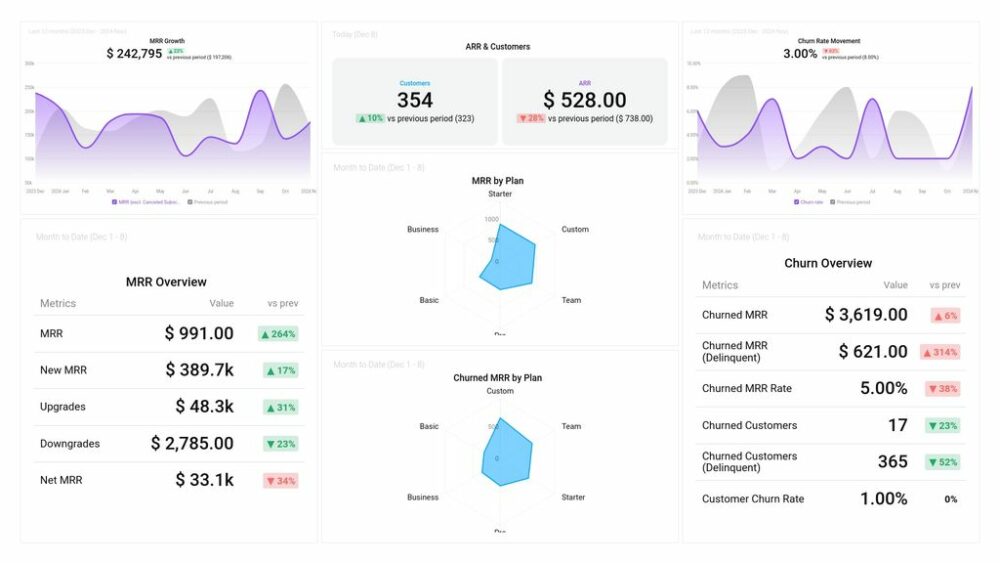
Mailchimp
With this connection, you can easily manage your email lists, segment contacts, and track campaign performance directly from HubSpot.
The integration also simplifies the process of creating personalized email campaigns. HubSpot’s CRM data feeds into Mailchimp, so you can target contacts based on lifecycle stages, recent activity, or custom properties.
For instance, you can send tailored welcome emails to new leads or re-engagement campaigns to inactive customers, all with better precision.
Rex Huxford of MD Clarity shared their perspective on this integration:
“HubSpot’s Mailchimp integration is a powerful tool for email automation. We can automate contact syncing between platforms and add subscribers to our CRM as they fill out site forms for real-time updates without any manual work.
Better yet, we can use HubSpot’s data to better understand email subscribers and segment our lists appropriately, combining metrics across platforms for a 360-degree view. Best yet, even if you’re using Mailchimp’s free plan, you can fully integrate it with HubSpot.”
How HubSpot Integrations Address Key Challenges and Goals
HubSpot integrations do more than strengthen your toolkit—they solve real problems.
From breaking down data silos to automating time-consuming tasks, these tools help you hit your goals faster and easier.
Here’s how the right integrations can solve common problems and keep you moving forward:
- Improving Paid Ads Performance with Better Organized CRM Data
- Streamlined Lead Nurturing
- Centralized Tracking of Email Marketing Metrics and KPIs
- Aligning Marketing and Sales Teams
- Increase Lead Conversions Without Sacrificing Interaction Quality
- Easier to Organize Scattered Customer Data
Improving Paid Ads Performance with Better Organized CRM Data
HubSpot paid ads integrations, such as Google Ads and Facebook Ads, sync your CRM data directly with your ad platforms.
With a CRM like HubSpot acting as the central hub, you can segment your audience based on lifecycle stages, purchase history, or even engagement patterns.
This segmentation helps you create highly targeted ad campaigns that resonate with specific groups, so you can reduce wasted ad spend and get a better ROI. For instance, retargeting ads can automatically reach contacts that interacted with your brand but haven’t converted.
The integration also simplifies performance tracking. Ad metrics such as clicks, conversions, and cost-per-lead are pulled into HubSpot, and your team gets a clear view of how each campaign is performing.
Manoj Kumar of Orderificsays that a “key challenge we faced was improving our ad performance and aligning it with our CRM data.”
“The Google Ads and HubSpot integration effectively addressed this challenge by linking our ad campaigns with HubSpot’s CRM. This connection allowed us to monitor ad performance, adjust targeting in real-time, and understand how ads influence customer interactions. As a result, we improved our ad spend and enhanced our marketing strategy.”
Streamlined Lead Nurturing
Effective lead nurturing can be complex – especially when you’re juggling multiple platforms and data sources. HubSpot integrations simplify this by creating a centralized system where marketing, sales, and customer data work seamlessly together.
When you connect tools like Mailchimp, LinkedIn Sales Navigator, or even your website’s forms with HubSpot, you can automate lead nurturing workflows.
For example, when a new lead enters your CRM, you can automatically enroll them in an email sequence personalized to their interests or lifecycle stage.
Moreover, every interaction—whether it’s an email open, a form submission, or a social media message—feeds back into HubSpot.
Hyfa Ahmad of Empxtrack says that a “particular challenge we faced was managing and nurturing leads generated from our webinars.”
“Our goal was to streamline the process of capturing attendee information, ensuring timely follow-up, and ultimately converting these leads into customers. This challenge was effectively addressed by integrating Zoom with HubSpot. Before the integration, our team struggled with manually importing attendee lists from Zoom into HubSpot, which was time-consuming and prone to errors.
The follow-up communications were often delayed, leading to missed opportunities and a fragmented lead nurturing process. With the HubSpot-Zoom integration, the entire workflow became automated and seamless. When someone registered for a webinar, their information was automatically captured in HubSpot, creating a new contact or updating an existing one. This eliminated the need for manual data entry and ensured that our contact database was always up-to-date.”
Roman Zrazhevskiy of MIRA Safety also shared one practical example of how the CRM integration with HubSpot has addressed a business challenge is in their lead management process:
“Previously, tracking and nurturing leads across different stages was cumbersome, often leading to missed opportunities. With HubSpot’s CRM, we’ve automated these processes, ensuring that no lead is left behind. This has directly contributed to an increase in our conversion rates, clearly demonstrating the value of this integration in achieving our sales goals.”
Andre Oentoro of Breadnbeyond is another respondent who talked about how HubSpot helped them “streamline the lead nurturing process.”
“Before the integration, manual data entry and email sequencing consumed valuable time and led to inconsistencies. With Zapier, we automated lead data syncing and triggered email sequences based on criteria, saving time and ensuring consistent engagement. As a result, lead engagement and conversions increased, driving revenue growth.”
Centralized Tracking of Email Marketing Metrics and KPIs
HubSpot integrations with Mailchimp and other email marketing tools can centralize your email campaign data within the CRM.
This way, you get seamless tracking and analysis of KPIs like open rates, click-through rates, and conversion rates—all in one place.
You can compare the performance of different campaigns side by side or monitor how specific segments respond to personalized emails.
These integrations also make reporting more efficient. HubSpot’s dashboards enable you to visualize your data, measure email ROI, and showcase your results to stakeholders without toggling between platforms.
Taylor Austin Dodds of BrandExtract says that “with the email integration, you can enable employees to track email opens and clicks in your CRM, even if the email is sent from the Gmail browser.”
“That helped my client track engagement on crucial emails. It also enabled us to track email engagement in the CRM, even for contacts who have opted out of marketing communications, which is huge for sensitive emails where we need to know the contact has received the information.”
PRO TIP: Are you using Mailchimp for your email marketing activities? If so, you may be interested in our free Mailchimp Overview Dashboard where you can compile all of your most important email metrics and centralize the data in one place. From open rates to email CTR, you can track the performance of your email campaigns in real-time.
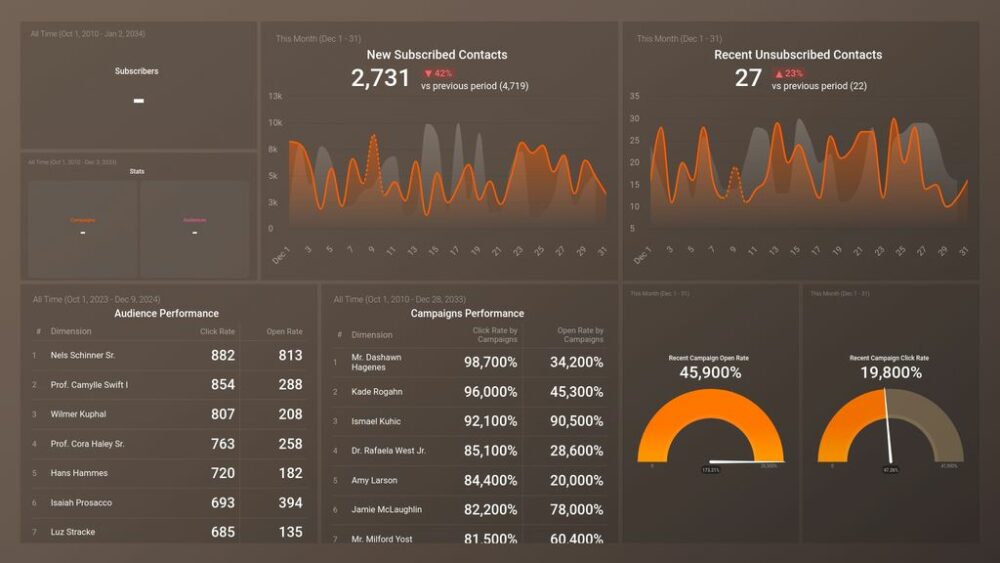
Aligning Marketing and Sales Teams
HubSpot integrations help align marketing and sales by creating a unified platform where both teams can access the same data, tools, and insights.
Integrating tools like LinkedIn Sales Navigator, Salesforce, or similar ones with HubSpot ensures that marketing efforts are seamlessly tied to sales outcomes.
Marketing teams can pass on qualified leads with detailed insights, such as engagement history and preferences, while sales teams can use this information to personalize outreach and close deals more successfully.
Sergey Taver of Precision Watches is one of our respondents who talked about this:
“One specific challenge we faced at Precision Watches was ensuring our marketing and sales teams were on the same page regarding lead quality and follow-up actions. By using the HubSpot and Salesforce integration, we managed to streamline the communication between both teams.
This not only increased our efficiency but also boosted our sales conversion rates by providing sales with high-quality leads that were ready to close. This tool has been essential in achieving our business goals of enhancing customer satisfaction and driving sales growth.”
“One particular challenge that was effectively addressed using the HubSpot-Salesforce integration was streamlining our lead management process. Prior to the integration, we faced difficulties in aligning marketing and sales efforts, resulting in leads getting lost or falling through the cracks. However, with the integration in place, we achieved seamless data synchronization between HubSpot and Salesforce, enabling automated lead routing, lead scoring, and more accurate reporting. This allowed our teams to prioritize and follow up with leads more efficiently, leading to a significant increase in lead-to-customer conversions and revenue generation.”
Want to get highlighted in our next report? Become a contributor now
Increase Lead Conversions Without Sacrificing Interaction Quality
Increasing lead conversions often comes at the risk of impersonal communication or rushed interactions.
HubSpot eliminates this trade-off and helps companies scale their efforts while maintaining meaningful, high-quality engagements with leads. You can connect tools like LinkedIn Sales Navigator to gain access to data and automation that improve personalization and efficiency.
These integrations also provide insights into the entire customer journey, so your sales teams can refine their approach and create interactions that align with each lead’s unique needs.
Tony Mariotti of RubyHome explained how one of their main goals was to “increase lead conversion without compromising the quality of client interactions.”
“By leveraging HubSpot’s sales enablement features, we were able to automate follow-ups and maintain personalized communication with potential clients. This strategy improved our conversion rates and allowed our team to focus more on creating personalized experiences for each client, ultimately enhancing customer satisfaction and loyalty.”
Easier to Organize Scattered Customer Data
Managing scattered customer data across multiple tools usually leads to missed opportunities.
HubSpot integrations simplify this by consolidating customer information from various platforms into a single CRM. With a centralized approach, teams can access complete, accurate, and up-to-date customer data without jumping between tools.
For example, integrating platforms like Shopify and Zendesk with HubSpot brings purchase history, support tickets, and sales activity into one place. Marketing teams can design campaigns based on customer behavior, sales teams can personalize their outreach, and support teams can address issues with full context.
Tim White of Milepro said how the HubSpot-Zendesk integration “helped us overcome the challenge of scattered customer data.”
“Before implementing this solution, our support team struggled to consolidate information from various sources, which led to delays and sometimes inaccuracies in handling customer issues. By integrating these platforms, we’ve significantly reduced response times and improved our resolution rates. This efficiency has directly contributed to an increase in customer satisfaction and loyalty, which are critical metrics for our success in the highly competitive travel sector.”
Maximize the Power of Your HubSpot Integrations with Databox
HubSpot’s powerful integrations with tools like Google Ads, Salesforce, and LinkedIn Sales Navigator can drive your business forward, but how do you truly measure their impact?
While these integrations provide huge value by streamlining workflows, the real challenge is understanding how they’re contributing to your bottom line.
And without clear, real-time insights into your performance, it’s easy to miss opportunities for optimization and growth.
This is where Databox comes in.
Databox takes your HubSpot data and consolidates it with all your other key tools—Google Analytics, Shopify, Mailchimp, and more—into one easy-to-use dashboard.
With Databox Dashboards, you can track the metrics that matter most in real-time, in one centralized view.
But we don’t stop there. Our Benchmark Groups give you immediate access to industry-specific performance data, so you can compare your results with those of similar businesses. You can see exactly where you stand, find areas for improvement, and refine your strategies to stay ahead of the competition.
With 130+ integrations, Databox makes it effortless to visualize your data and understand how all your HubSpot integrations are performing in tandem.
Whether you’re looking to optimize your ad spend, increase lead conversions, or improve customer relationships, Databox puts all the insights you need in one place.
So, why guess when you can know? Sign up for a free Databox trial and see the full potential of your HubSpot integrations.

















